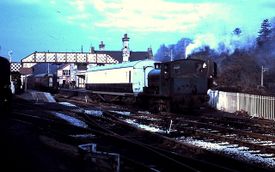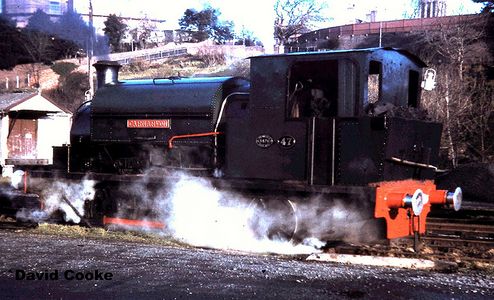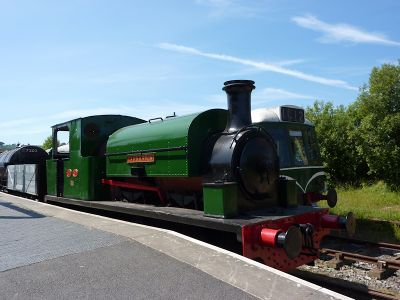Kitson & Co 5474 'Carnarvon'
| Kitson & Co 5474 'Carnarvon' | |
|---|---|
 Carnarvon shunts at Bridgnorth in 1969 | |
| Built By | Kitson & Co |
| Configuration | 0-6-0 |
| Loco Number | Works No 5474 |
| Other Numbers | 47 |
| History | |
| Built | 1934 |
| Designed By | Manning, Wardle & Co |
| 1969 | Arrived on SVR |
| 1970 | Left the SVR for Hereford |
| 1993 | Moved to the South Devon Railway |
| Technical | |
| Length | 29ft 0" |
| Weight | 31t |
| Tractive effort | 18,200 lb approximate |
| Pressure | 160 lb/sq in |
Kitson & Co 0-6-0ST 'Carnarvon', Works No. 5474 of 1934 was briefly resident on the SVR. It arrived in 1969 and was used on engineers' trains, but left in 1970 following a dispute between the SVR and the owning group.
Contents
'Carnarvon' in service
The locomotive was built by Kitson & Co of Leeds in 1934 for Stewarts and Lloyds. The locomotive was built to a Manning Wardle design which Kitson acquired when Manning Wardle closed in 1926: the design dates from around 1917 when Manning Wardle built six locomotives for Stewarts and Lloyds to work at the quarry at Corby.[1] The locomotive has 4ft 0in diameter wheels and two 16in inside cylinders.
At Stewarts and Lloyds, the locomotive became No. 47. A number of their locomotives carried the (anglicised) names of Welsh towns in tribute to the Welsh wife of the owner of the company, with No. 47 receiving the name 'Carnarvon' (without the "e"). 47's working life was spent at Corby, hauling iron ore from local quarries to the iron works.
'Carnarvon' in preservation
In 1969, Stewards and Lloyds acquired 23 Paxman Type-1 diesels from Hull Dairycoats shed. This enabled the company to eliminate steam almost overnight from their extensive railway system. Many of the steam locomotives were still in good condition and rather than sending them for scrap, Stewarts and Lloyds agreed to offer them first to preservation societies through the ARPS.
The Worcester Locomotive Society's primary goal was the acquisition of GWR Pannier 5786. However four Kitson-built inside cylinder 0-6-0 saddle tanks including 'Carnarvon' were offered for as little as £330 each and were thought to be 'well worthwhile', being a relatively uncommon type.[note 1] The low price meant that one could be bought without jeopardising the Society's 'Pannier Tank Fund'. After a thorough examination, No 47 was purchased by the Society on 1 August 1969 in excellent working order with plenty of spare parts.[2]
After acquisition, both locomotives were moved to the SVR where No 47 spent the winter of 1969-70 on engineers' trains. The SVR was still preparing to open to the public at that time; all engineers trains were steam-hauled as the first diesel locomotives had yet to arrive. However in summer 1970, the SVR's solicitor Richard Dunn announced that the SVR and the W.L.S. had failed to agree the terms on which the two locomotives would remain on the SVR. The dispute centred around the requirement that only paid up members of the Severn Valley Railway Company could work on or operate locomotives on the railway as required by the SVR's insurers and the Inspecting Officer of Railways.[3]
The Society initially moved their locomotives to the Bulmers Railway Centre at Hereford. During the oil crisis in 1973, 'Carnarvon' was reportedly used to shunt wagons of cider apples for Bulmers (a producer of cider), in place of the usual diesel shunters[4].
When the Bulmers Centre eventually closed, No 47 found a new home in 1993 at the South Devon Railway. There it was initially used to give footplate and brake van rides until that practice was ended as the locomotive was not vacuum fitted. After that time, it was used on Members Only days and occasional goods trains.[5] The photograph below shows 'Carnarvon' on static display at Totnes in 2010.
See also
Notes
- ↑ The contemporary report in SVR News referred to four of these locomotives. No. 44 'Conway' and No. 45 'Colwyn' are preserved at the Middleton Railway and the Northampton & Lamport Railway respectively. The fate of the fourth example is not recorded.
References
- ↑ Preserved British Steam Locomotives
- ↑ SVR News 14
- ↑ SVR News 17
- ↑ Comments on Flickr photo of Carnarvon at Hereford
- ↑ South Devon Railway
Links
- Preserved British Steam Locomotives
- Stewarts and Lloyds, Grace's Guide to British Industrial History
- South Devon Railway
| ||||||||||||||||||||||||||||||||||



